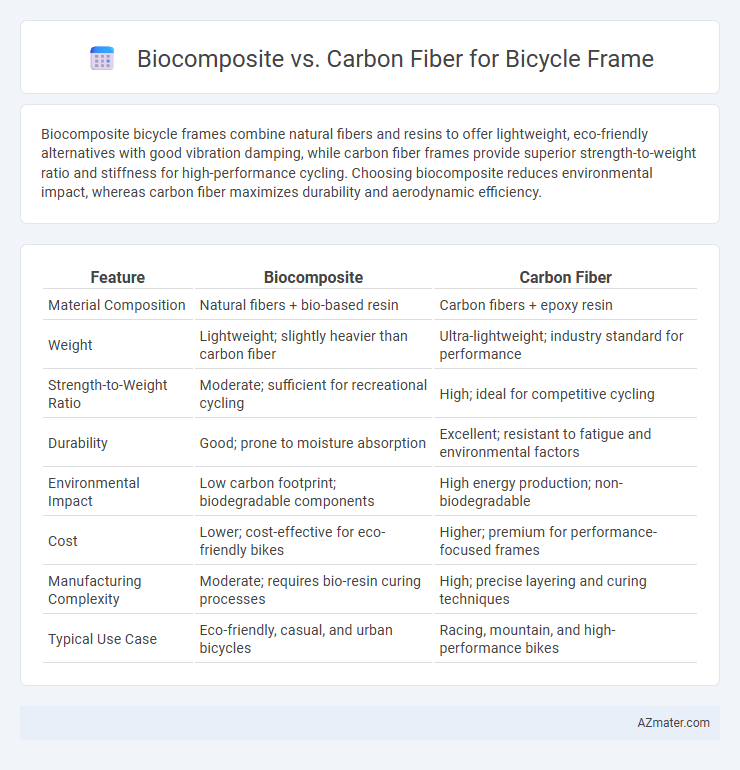Biocomposite bicycle frames combine natural fibers and resins to offer lightweight, eco-friendly alternatives with good vibration damping, while carbon fiber frames provide superior strength-to-weight ratio and stiffness for high-performance cycling. Choosing biocomposite reduces environmental impact, whereas carbon fiber maximizes durability and aerodynamic efficiency.
Table of Comparison
| Feature | Biocomposite | Carbon Fiber |
|---|---|---|
| Material Composition | Natural fibers + bio-based resin | Carbon fibers + epoxy resin |
| Weight | Lightweight; slightly heavier than carbon fiber | Ultra-lightweight; industry standard for performance |
| Strength-to-Weight Ratio | Moderate; sufficient for recreational cycling | High; ideal for competitive cycling |
| Durability | Good; prone to moisture absorption | Excellent; resistant to fatigue and environmental factors |
| Environmental Impact | Low carbon footprint; biodegradable components | High energy production; non-biodegradable |
| Cost | Lower; cost-effective for eco-friendly bikes | Higher; premium for performance-focused frames |
| Manufacturing Complexity | Moderate; requires bio-resin curing processes | High; precise layering and curing techniques |
| Typical Use Case | Eco-friendly, casual, and urban bicycles | Racing, mountain, and high-performance bikes |
Introduction: Evolution of Bicycle Frame Materials
Bicycle frame materials have evolved from traditional steel and aluminum to advanced composites like carbon fiber and biocomposites, driven by the demand for lightweight, durable, and sustainable options. Carbon fiber offers exceptional strength-to-weight ratios and stiffness, making it the preferred choice for high-performance racing bikes. Biocomposites, combining natural fibers with resins, provide an eco-friendly alternative with competitive mechanical properties, aligning with growing environmental concerns in the cycling industry.
What Are Biocomposites?
Biocomposites are materials composed of natural fibers, such as flax, hemp, or jute, embedded in a polymer matrix, offering a sustainable alternative to traditional composites. These materials provide lightweight properties and good mechanical strength while reducing environmental impact compared to carbon fiber. In bicycle frames, biocomposites deliver vibration damping and improved eco-friendliness, making them an increasingly attractive choice for sustainable performance cycling.
Understanding Carbon Fiber in Bicycle Frames
Carbon fiber in bicycle frames offers exceptional strength-to-weight ratio, providing lightweight yet highly durable performance ideal for competitive cycling. Its molecular structure allows for precise layering and alignment, resulting in superior stiffness and responsiveness compared to traditional materials. Advanced manufacturing techniques enable customized frame designs that optimize ride quality and aerodynamic efficiency.
Strength and Durability Comparison
Biocomposite bicycle frames offer excellent strength-to-weight ratios with improved impact resistance due to natural fiber reinforcement, making them highly durable under diverse riding conditions. Carbon fiber frames boast superior tensile strength and stiffness, providing enhanced performance and rigidity, but they can be more susceptible to catastrophic failure under extreme impact. Both materials deliver competitive durability, with biocomposites excelling in environmental resilience and carbon fiber in high-stress endurance.
Weight Differences: Biocomposite vs Carbon Fiber
Carbon fiber bicycle frames typically weigh between 700 to 1,200 grams, offering a superior strength-to-weight ratio compared to biocomposite frames, which generally range from 900 to 1,500 grams. Biocomposite materials, combining natural fibers like flax or hemp with resin, provide a moderate weight advantage over traditional metals but remain heavier than pure carbon fiber composites. Despite slightly increased weight, biocomposites offer environmental benefits and sufficient durability for many cycling applications.
Sustainability and Environmental Impact
Biocomposite bicycle frames use natural fibers like flax or hemp combined with biodegradable resins, offering lower carbon emissions and reduced environmental footprint compared to carbon fiber. Carbon fiber frames, while highly durable and lightweight, require energy-intensive manufacturing and are challenging to recycle, leading to significant ecological concerns. Choosing biocomposites enhances sustainability by promoting renewable materials and easier end-of-life disposal, making them a greener alternative in bicycle frame production.
Ride Quality and Performance Metrics
Biocomposite bicycle frames offer enhanced vibration damping and a smoother ride quality due to natural fiber reinforcements, making them ideal for endurance cycling and comfort-focused rides. Carbon fiber frames deliver superior stiffness-to-weight ratios, translating into higher responsiveness, power transfer efficiency, and overall performance metrics favored in competitive racing. The choice between biocomposite and carbon fiber frames depends on prioritizing ride comfort versus maximizing lightweight performance and aerodynamic efficiency.
Cost Analysis: Affordability and Longevity
Biocomposite bicycle frames typically offer lower initial costs compared to carbon fiber frames, making them more affordable for budget-conscious riders. Carbon fiber frames provide superior durability and longevity, often justifying their higher price with extended lifespan and enhanced performance. Cost analysis reveals biocomposites excel in upfront savings while carbon fiber maximizes value over time through durability and reduced maintenance expenses.
Repairability and End-of-Life Considerations
Biocomposite bicycle frames offer enhanced repairability due to their natural fiber composition, allowing easier patching and reshaping compared to the rigid structure of carbon fiber. Carbon fiber frames, while lightweight and strong, often require specialized repair techniques that can be costly and may not restore original strength fully. At end-of-life, biocomposites present superior environmental benefits through biodegradability and recyclability, contrasting with carbon fiber's challenging disposal process that commonly results in landfill accumulation or energy-intensive recycling.
Future Trends in Bicycle Frame Materials
Biocomposite bicycle frames are gaining traction due to their sustainability, lightweight properties, and ability to reduce carbon footprints, positioning them as a key material in eco-friendly transportation innovation. Carbon fiber remains dominant for its superior strength-to-weight ratio and stiffness, but advancements in bio-based resins and hybrid composites are enhancing its environmental profile. Future trends indicate increased integration of recyclable biocomposites combined with high-performance carbon fibers, promoting durability and sustainability in next-generation bicycle frame designs.

Infographic: Biocomposite vs Carbon Fiber for Bicycle Frame
 azmater.com
azmater.com